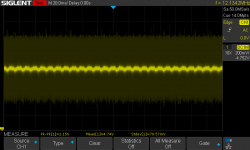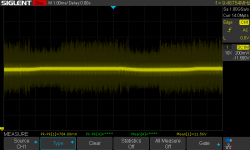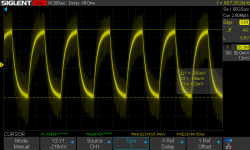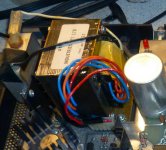robjordan
Member
Hi all
I'm working on my old Exidy Sorcerer. It's unmodified since my dad came home with it in 1979. It works, but I'm noticing there seems to be a lot of high frequency noise on the power supply, and also on the tape MIC and AUX outputs, which I'm guessing is a consequence of the power supply noise. I'm a novice and I don't know what is a normal amount and frequency of noise for a linear-regulated supply of this vintage. I took some scope pictures to illustrate.
5V rail: Mean: 4.8V, Pk-Pk over a couple of seconds 1.2V, stddev: 70mv.

12V rail: Mean: 11.6V, pk-pk over 15ms: 784mV

AUX out 1200 Hz tone, amplitude is 216mV with about +/-50mV noise either side of the signal.

The MIC out signal, which is only meant to be 50mV, seems totally drowned in noise.
I'm guessing this isn't normal, and that some re-capping will be needed. I ran a leakage test on the gigantic 8000uF capacitor, which is easily-removed. It didn't indicate any significant leakage to the best of my understanding (leakage current @ 15V was about 30uA after 5 minutes and then slowly reduced to 20uA.
Should I replace all the caps in the PS, or is there a way I can diagnose the source of the problem?
Incidentally, does anyone ever replace the linear power supply with a switched-mode one, or would that be sacrilege? It runs incredibly hot, even - I discovered after leaving it plugged in one night - if the power switch in the system unit is turned off, which I don't really understand as the schematics show the power switch disconnects the transformer primary. Could there me a fault in the power line filter?
I should add it's a 240V/50Hz model. Schematic for the power supply here in case it's helpful.
Rob
I'm working on my old Exidy Sorcerer. It's unmodified since my dad came home with it in 1979. It works, but I'm noticing there seems to be a lot of high frequency noise on the power supply, and also on the tape MIC and AUX outputs, which I'm guessing is a consequence of the power supply noise. I'm a novice and I don't know what is a normal amount and frequency of noise for a linear-regulated supply of this vintage. I took some scope pictures to illustrate.
5V rail: Mean: 4.8V, Pk-Pk over a couple of seconds 1.2V, stddev: 70mv.

12V rail: Mean: 11.6V, pk-pk over 15ms: 784mV

AUX out 1200 Hz tone, amplitude is 216mV with about +/-50mV noise either side of the signal.

The MIC out signal, which is only meant to be 50mV, seems totally drowned in noise.
I'm guessing this isn't normal, and that some re-capping will be needed. I ran a leakage test on the gigantic 8000uF capacitor, which is easily-removed. It didn't indicate any significant leakage to the best of my understanding (leakage current @ 15V was about 30uA after 5 minutes and then slowly reduced to 20uA.
Should I replace all the caps in the PS, or is there a way I can diagnose the source of the problem?
Incidentally, does anyone ever replace the linear power supply with a switched-mode one, or would that be sacrilege? It runs incredibly hot, even - I discovered after leaving it plugged in one night - if the power switch in the system unit is turned off, which I don't really understand as the schematics show the power switch disconnects the transformer primary. Could there me a fault in the power line filter?
I should add it's a 240V/50Hz model. Schematic for the power supply here in case it's helpful.
Rob



